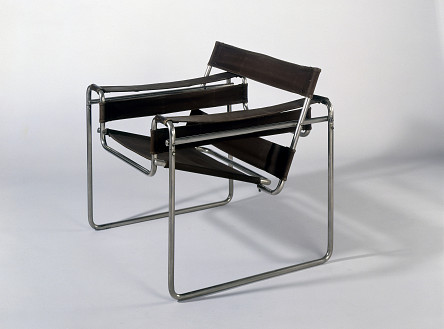
Marcel Breuer, Tubular steel armchair, design 1925-1926 Bauhaus-Archiv Berlin, Photo: Fotostudio Bartsch
By his own account, it was bicycle handlebars that inspired Breuer to create his tubular steel chair.
Marcel Breuer headed the Furniture Workshop at the Bauhaus from 1925 to 1928. During that time, he designed the first tubular steel chair in the history of design: the B3 chair (later also known as Wassily). Up to that time, steel tubing had mainly been used for hospital furniture. Breuer developed it into a ‘club chair’ for the living-room – not the kind of heavy, upholstered chair previously seen, but a light seat designed for industrial production. Although it was some time before industrial manufacturing of the tubular steel armchair followed and the later versions were welded and inserted, making them difficult to dismantle, its open construction reduced to only a few elements perfectly matched the Bauhaus’s functional aesthetic.
The Furniture Workshop was thus one of the first workshops to accept the need for standardization for the purposes of industrial production. After Breuer had left the Bauhaus, its character shifted more strongly under Hannes Meyer towards furniture that had been developed to production stage and towards multifunctional furniture items made of simple materials, such as Josef Pohl’s so-called ‘Bachelor’s Wardrobe’. ‘People’s necessities, not luxuries’ [‘Volksbedarf statt Luxusbedarf’] was now the motto, after the tubular steel furniture had become fashionable among intellectuals. Under Ludwig Mies van der Rohe, finally, the workshop was attached to the Interior Finishing department – partly because the link between production operations and college work appeared contradictory to him. In fact, many of the famous classics of modernism that are today regarded as ‘Bauhaus models’ were created outside of college work. However, none of the workshops shaped the image of the Bauhaus as much as the Furniture Workshop did.